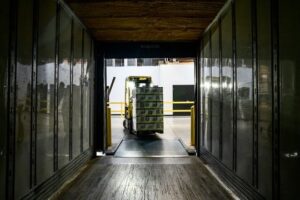Making your cross-docking project a success: Steps, tools and pitfalls to avoid for a successful transition
WMS software
Logistics
Supply Chain
October 3, 2025

Take a few minutes to imagine this perfectly orchestrated ballet: your goods arrive at the dock, are immediately sorted, and almost immediately leave for their final destination—all in less than 24 hours. No more unnecessary storage costs, no more shortages due to dormant inventory.
This is the promise of cross-docking.
Far from being just a trendy concept, cross-docking is a logistics flow management method that, if properly mastered, can radically transform your warehouse.
But be careful, such fluidity cannot be improvised. It requires perfect synchronization, the right technologies, and organization down to the last detail. At the heart of this logistics reactor is an essential tool: WMS (Warehouse Management System) software.
This article is your complete guide to understanding and mastering cross-docking. We'll deconstruct its mechanisms, explore the technologies that make it possible, and show you, through concrete examples, how to transform your receiving and shipping docks into real-world profit centers.
Cross-Docking: Defining a just-in-time logistics strategy
Cross-docking is a logistics organization method that involves moving goods from a goods receiving dock to a delivery dock with minimal delay , ideally less than 24 hours.
The fundamental principle? Eliminate the medium- or long-term storage management phase.
Unlike the traditional logistics scheme where products are received, checked, stored, then retrieved via picking for order preparation, cross-docking eliminates the most costly and time-consuming step: warehouse storage .
The product only “crosses the dock”.
This approach fits perfectly with a just-in-time and cost-reduction approach. By minimizing product handling and storage space requirements, you gain agility and performance. It's the antithesis of the stock warehouse. Here, the warehouse becomes a sorting and consolidation platform, a dynamic node within your supply chain.
The different forms of cross-docking
Cross-docking is not a rigid method. It can be adapted depending on the nature of the products and the specific needs of your business. There are three main types of processes:
- Consolidated (or continuous) Cross-Docking : This is the "purest" form. The pallets or packages received are already identified for an end customer. The operation simply consists of moving them from the arrival dock to the corresponding departure dock, without any modification. This method requires perfect synchronization with suppliers who must prepare orders in advance. This is the typical case for high-rotation products.
- Consolidation Cross-Docking (or deconsolidation/regrouping) : Here, goods arrive in larger batches (e.g., single-item pallets). On the platform, operators break down these batches to create new, customized orders for different customers. This packing or co-packing step allows products from various suppliers to be grouped into a single shipment, thus optimizing transport management.
- Hybrid Cross-Docking : This is a pragmatic approach that combines the just-in-time flow of cross-docking with a small portion of warehouse inventory. During consolidation on the platform, products arriving from suppliers are supplemented with a few items taken from the traditional storage management area. This makes it possible to fulfill more complex orders while benefiting from the advantages of cross-docking for the majority of the flow.
The choice between these methods depends on your objectives: pure acceleration, delivery optimization, flexibility... Whatever the option, the goal remains the same: to ensure that the goods never stop moving.
Prerequisites for effective cross-docking: Organization, technology and synchronization
Implementing cross-docking isn't just about pushing pallets from one truck to another. It's a profound transformation of your logistics flow that relies on three inseparable pillars.
A flawless physical and human organization
Even before talking about technology, space organization is a sine qua non condition. The cross-docking platform must be designed for fluidity. This generally involves a receiving area, a sorting and preparation area, and a shipping area , all arranged to minimize movement and avoid flow crossovers.
Staff must be trained for this new pace. Operations are fast-paced and require precision and responsiveness. The versatility of operators, who can quickly move from receiving to inspection and then shipping, is a real asset. Also, implementing visual management systems and poka yoke (error-proof devices) helps reduce risks and ensure quality despite the speed of execution.
Synchronization with partners is equally important. Transparent, real-time communication with suppliers and carriers is the keystone of the system. Suppliers must adhere to strict labeling and packaging specifications to ensure products are identifiable upon arrival.
Technology: The brains of the operation
Large-scale cross-docking is simply impossible without robust technological support. The Warehouse Management System (WMS) is the centerpiece of this ecosystem.
WMS software goes far beyond simple inventory management. In a cross-docking context, it becomes the conductor that controls all operations in real time.
- Upon receipt of goods : The WMS instantly identifies products using barcodes or RFID chips, compares them to expected orders and immediately determines their destination: departure dock, consolidation area, etc.
- During sorting : It guides operators via mobile terminals or voice systems, telling them where to route each package or pallet. It optimizes the routes of forklifts and order pickers.
- At shipping : The WMS ensures that the right goods are loaded onto the right truck, generates transport documents and communicates the information to the TMS (Transport Management System).
The WMS guarantees real-time traceability . Every movement is recorded, providing total visibility of logistics flows. This traceability makes it possible to manage unforeseen events and provide reliable information to customers.
Perfect Flow Synchronization: The Art of Just-in-Time
Cross-docking is the epitome of Just-in-Time. Success depends on the ability to perfectly match incoming flows (from suppliers) and outgoing flows (to customers).
This balance is fragile. A truck delay upstream can paralyze part of the dock and delay many orders downstream. This is why rigorous planning and complete visibility into transportation management are absolutely essential.
Peak activity must be anticipated and managed with surgical precision. Scheduling appointments at loading and unloading docks becomes a strategic function , often managed by specific modules or complementary systems such as YMS.
Cross-docking prerequisite checklist:
- Organizational:
- Warehouse layout promoting linear flow (receiving, sorting, shipping area).
- Training teams in versatility and speed.
- Establishing clear processes and poka yoke devices.
- Establishment of precise specifications with suppliers (labeling, packaging, delivery slots).
- Technological:
- Deployment of a WMS solution to manage flows in real time.
- Equipping operators with mobile terminals (scanners, voice picking).
- Integration of WMS with ERP and TMS.
- Synchronization:
- Implementation of an appointment booking system for carriers.
- Real-time communication tools with partners (suppliers, carriers).
- Data analysis capability to anticipate activity peaks and plan resources.
The central role of WMS and Yard Management System (YMS) in dock orchestration
If cross-docking were an orchestra, WMS software would be the conductor and the Yard Management System (YMS) would be the concert hall manager. Their synergy, often complemented by a TMS (Transport Management System), is the key to smooth logistics.
The WMS: The real-time brain of the platform
In a cross-docking platform, the Warehouse Management System transcends its traditional role as inventory management . It doesn't just know where things are; it decides where they should go, down to the second.
As soon as a truck arrives at the dock, the WMS takes control. By scanning the Advanced Shipping Number (ASN) information provided by the shipper, the system knows exactly what's on the truck before the doors even open.
It can then allocate tasks in real time:
- Dynamic dock assignment : The WMS assigns the truck to the most suitable unloading dock based on the loading docks planned for the goods it is transporting, in order to minimize transit distances.
- Operator guidance : It sends precise instructions to the forklift terminals: “Take pallet A, place it on the transit location for platform 12”.
- Consolidation orchestration : For hybrid or consolidation cross-docking, the WMS orchestrates the “meeting” between incoming flows and items to be picked from stock, thus optimizing the order preparation sequence.
Without an agile and responsive WMS solution, cross-docking would quickly turn into chaos, with bottlenecks, misrouting, and a complete loss of expected benefits. In other words, the WMS is the tool that ensures the smoothness and reliability of the process.
The YMS: Extending Control Beyond the Warehouse Walls
The performance of a cross-docking platform isn't just a function of the warehouse, but also of the yard. An uncontrolled influx of trucks, drivers looking for their dock, trailers parked in the wrong place... all of this creates friction that slows down the entire chain.
This is where the Yard Management System (YMS) comes in.
The YMS is your warehouse yard traffic control system . It manages the flow of trucks and trailers from the moment they arrive on site until they leave.
Its key functions include:
- Online appointment booking : Carriers reserve delivery and collection slots, which helps smooth out activity and avoid congestion.
- Entry and exit management : The YMS automates the registration of trucks at the gate, verifies documents and assigns them a parking space or dock.
- Real-time visibility : It provides an overview of all vehicles on site, their status (waiting, docked, loading/unloading) and their exact location.
By integrating with the WMS, the YMS acts as a smart airlock . It ensures that the right truck arrives at the right dock, at the right time, when the WMS and teams are ready to process it. It is this perfect synchronization between the yard and the warehouse that keeps the frenetic pace of cross-docking running.
The winning trilogy: WMS + YMS + TMS
For optimal performance, these two systems must communicate with a third player: the Transport Management System (TMS). To summarize:
- The TMS plans and optimizes upstream and downstream transport routes.
- The YMS manages the reception and flow of carriers on site.
- The WMS orchestrates the unloading, sorting and loading operations within the platform.
When these three systems communicate seamlessly, the supply chain achieves exceptional efficiency. The TMS informs the YMS of a truck's imminent arrival, the YMS picks it up, and notifies the WMS when it's docked. The WMS executes the operations and then informs the TMS that the order is ready to go, enabling proactive transportation management and real-time end-to-end traceability.
This integration is the foundation of modern warehouse automation and the sine qua non of a successful large-scale cross-docking project.
Case studies: How leaders are reducing costs through cross-docking
Theory is one thing, but practice is another. Many leading companies have made cross-docking a pillar of their logistics strategy, demonstrating its incredible potential.
Walmart: The pioneer of large-scale cross-docking
We can't talk about cross-docking without mentioning Walmart. The American retail giant was one of the first to deploy this strategy on a massive scale back in the 1980s.
Their model is an example of consolidated cross-docking . Suppliers prepare and label goods for each specific store before shipping them to Walmart's distribution centers. Upon arrival, pallets are not stored. They are scanned, routed across the dock, and loaded directly onto delivery trucks heading to the stores.
Using this method, Walmart has managed to:
- Drastically reduce its inventory management costs : nearly 85% of their products pass through their cross-docking network.
- Reduce storage space requirements , freeing up capital and reducing real estate costs.
- Accelerate product placement on shelves , ensuring better availability for customers and faster stock turnover.
Walmart's success is based on extremely close collaboration with its suppliers and a massive investment in WMS software to synchronize millions of movements every day.
Toyota: Cross-docking in the service of industrial “Just-in-Time”
Cross-docking isn't just for retailers. In the automotive sector, Toyota uses it to supply its production lines according to "Just-in-Time" principles.
Parts from different suppliers are transported to cross-docking platforms located near assembly plants. At these platforms, parts are sorted, grouped into specific kits for each stage of the assembly line, and delivered to the line at the precise moment they are needed.
This approach allows Toyota to:
- Minimize component inventories at production sites, which are extremely expensive.
- Gain flexibility to quickly adapt production to variations in demand.
- assembly line efficiency
Here, cross-docking is an essential link in the production supply chain, ensuring that the logistics flow of components is as smooth and optimized as the assembly line itself.
The fashion and e-commerce sector
In sectors where collections are ephemeral and delivery times are a key purchasing criterion, cross-docking is a formidable weapon. Players like Zara and major e-commerce use it to quickly move new collections from production centers to points of sale or final delivery hubs.
The process often involves a consolidation and co-packing step, where garments are sorted, sometimes put on hangers or repackaged, before being shipped. The speed of cross-docking helps reduce time-to-market and respond to seasonal or promotional peaks with maximum agility.
These examples show that, whatever the sector, cross-docking, when supported by a rigorous organization and technological tools such as WMS and YMS software, is a formidable lever for economic and operational performance.
Implementing Cross-Docking: Your 5-Step Action Plan
Adopting cross-docking is a transformational project that requires a structured approach. Here are the key steps for successful implementation.
Step 1: Analyze relevance and define objectives
Cross-docking isn't a one-size-fits-all solution. The first step is to assess whether this strategy is right for your products and market. Ideal candidates are typically high-moving products, perishable goods, promotional items, or orders already prepared by the supplier.
- Analyze your product catalog : Identify the references that could transit in just-in-time flow.
- Quantify potential gains : Estimate savings on storage, handling and transportation costs.
- Define clear objectives (KPIs) : “Reduce transit time from 48 hours to 12 hours”, “Transfer 30% of our flows to cross-docking in 1 year”.
Step 2: Involve partners and define processes
Cross-docking is a team sport. Your success depends on collaboration with your suppliers and carriers.
- Organize workshops with your key partners to present the project to them.
- Develop a common specification : standardization of labels (GS1-128 barcodes), palletization format, data transmission (ASN), compliance with delivery slots.
- Redefine your internal processes : map the new logistics flow from receipt to dispatch, clearly defining the roles and responsibilities of each player.
Step 3: Adapt the physical and technological infrastructure
This is the implementation stage. You need to make sure your warehouse and information systems are ready.
Checklist for infrastructure adaptation:
- Physical :
- Develop or redevelop a dedicated cross-docking area with a sufficient number of dock doors.
- Optimize the layout for a short and direct route between the arrival and departure platforms.
- Equip yourself with suitable handling equipment (trolleys, conveyors, sorters).
- Technological:
- Check that your WMS software has a module or advanced cross-docking features (ASN reception, dynamic assignment, etc.). If not, plan an upgrade or change.
- Integrate your WMS with your YMS and TMS for seamless management of physical and information flows.
- Deploy the necessary equipment: RF terminals, scanners, robust Wi-Fi infrastructure throughout the warehouse.
Step 4: Train teams and launch a pilot project
Change must be supported. Your teams are at the forefront of this new organization.
- Communicate the vision : Explain the reasons for the change and the expected benefits for the company and for them (fewer repetitive and physical tasks).
- Train operators on new processes and new tools (use of WMS on mobile terminal, etc.).
- Start with a pilot project : Select a supplier and a limited product scope to test the end-to-end process, identify friction points and adjust procedures before a large-scale deployment.
Step 5: Deploy, measure and continuously improve
Once the pilot is validated, deployment can begin. But the work doesn't stop there.
- Gradually roll out cross-docking to other suppliers and product lines.
- Track your KPIs in real time via your WMS dashboards: transit time on the platform, appointment compliance rate, error rate, etc.
- Organize regular meetings with your teams and partners to gather feedback and identify areas for improvement. Cross-docking is a process of continuous improvement.
Cross-docking to transform your dock into a growth lever
As we've seen, cross-docking is much more than just a logistics technique. It's a powerful strategy that directly addresses market demands: speed, cost reduction, and agility. By eliminating the storage step, you transform your warehouse from a static cost center into a dynamic, value-creating platform.
However, this performance comes at a price: rigor and synchronization . A cross-docking project cannot succeed without impeccable organization, close collaboration with your partners and, above all, a robust technological base.
WMS software, coupled with a YMS and TMS, is the central nervous system of this just-in-time operation. It provides the intelligence, visibility, and real-time traceability essential for orchestrating this complex logistical ballet. Investing in a suitable WMS solution isn't an expense; it's the catalyst that will unlock the full potential of cross-docking.
By mastering this strategy, you'll not only reduce your inventory management costs; you'll offer your customers faster, more reliable service, and give your supply chain a decisive competitive advantage for years to come.
Is your warehouse ready to take on the cross-docking challenge?
Contact us to assess the potential of this strategy for your business. Together, we'll analyze how our WMS solution can transform your docks into profit centers.
FAQ: Everything you need to know about cross-docking
What is the main difference between cross-docking and traditional logistics?
The fundamental difference lies in the elimination of the long-term storage management step. In a traditional model, goods are stored after receipt, sometimes for several days or weeks. In cross-docking, goods are sorted and reshipped in less than 24 hours, with their stay in the warehouse reduced to a minimum.
Is cross-docking suitable for all types of products?
No, not necessarily. It's particularly effective for fast-moving (mass-market) products, perishable goods, press products, promotional items, pre-prepared e-commerce orders, or components for just-in-time production. Products with slow turnover or unpredictable demand are less suitable for this method.
Is a WMS mandatory for cross-docking?
For a very small-scale operation, it's theoretically possible to do without it, but it quickly becomes unmanageable and error-prone. For professional, reliable, and efficient operations, WMS software is essential. It ensures instant product identification, routing to the correct dock, real-time traceability, and flow synchronization—the very essence of cross-docking.
What are the main risks associated with cross-docking?
The major risk is disruption of synchronization. A delay by a supplier or carrier can create a domino effect and disrupt the entire supply chain. Poor coordination can lead to bottlenecks on the docks. Finally, the speed of the process increases the risk of errors if controls are not rigorous and supported by reliable technology (such as scanning via warehouse management software).
How to measure the return on investment (ROI) of a cross-docking project?
ROI is calculated by comparing gains to investments.
- Benefits : Savings on real estate costs (less storage space), reduction in handling and personnel costs related to storage and picking, reduction in stock holding costs, improvement in service quality (shorter lead times).
- Investments : Cost of the WMS/YMS solution, possible redevelopment of the warehouse, purchase of specific handling equipment, cost of team training and change management.
Most read articles
WMS software
Logistics
Supply Chain
October 3, 2025
Making your cross-docking project a success: Steps, tools and pitfalls to avoid for a successful transition
Imagine: your goods arrive at the dock, are immediately sorted, and almost immediately depart for their final destination—all in less than 24 hours. No more unnecessary storage costs, no more shortages due to dormant inventory. That's the promise of cross-docking.
WMS software
Logistics
Supply Chain
September 29, 2025
Hazardous Materials Management: How Does a WMS Ensure Compliance and Safety?
Managing flammable, toxic, corrosive, or explosive products isn't just a logistical constraint; it's an immense responsibility, governed by highly complex regulations. Indeed, managing hazardous materials is a daily challenge that leaves no room for improvisation.
WMS software
Logistics
Supply Chain
July 3, 2024
Inventory management using WMS software
To master your inventory management, it is imperative to use suitable and efficient inventory management software. With this automation, you can monitor the status of your inventory in real time, allowing you to make informed and rapid decisions to avoid stock-outs or overstocks.

















